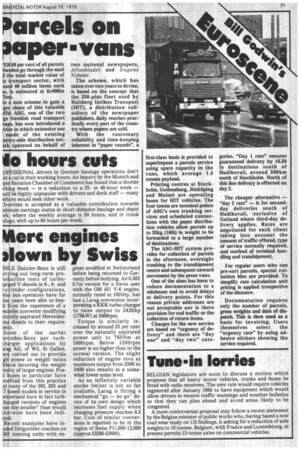erc engines s own by Swiss
Page 33

If you've noticed an error in this article please click here to report it so we can fix it.
E Daimler-Benz is still Lrr ing out long-term preuction tests of turboed V-diesels in 6-, 8and under configurations, vis bus operators have for years been able to benit rom the experience of a ec alist converter modifying itu ally aspirated Mercedesdiesels to their requireen s.
S me of the earlier er edes-Benz psv turb± rger applications by IIAG, of Wil, St Gallen, er carried out to provide gh power to weight ratios ith ut incurring the weight lty of larger engines. Pos.1 uses in particular have ?.n fited from this practice id many of the 302, 303 and 7ased models in service in vi zerland have in fact turbth rged versions of engines )n4 size smaller" than would th rwise have been indiite R cent examples have inuded Drogmoller coaches on 30 running units with en gines modified in Switzerland before being returned to Germany before bodying. An 0.303 8.7m version for a Swiss user with the OM 401 V-6 engine, normally rated at 192bhp, has had a Larag conversion incorporating a KKK turbo-charger to raise output to 242bhp (178kW) at 2400rpm.
Torque is similarly increased by around 25 per cent over the naturally aspirated power unit to 765Nm • at 1600rpm. Below 1200rpm power is no higher than in the normal version. The slight reduction of engine revs at maximum output from 2500 to 2400 also results in a somewhat lower noise level.
As an infinitely variable smoke limiter is not so far available, Larag is fitting a mechanical "go — no go" device of its own design which increases fuel supply when charging pressure reaches 0.3 bar. Cost of similar conversions is reported to be in the region of Swiss F11,000-12,000 (approx C3300-0600). first-class basis is provided to superimpose a parcels service using spare capacity in the vans, which average 1.5 tonnes payload.
Printing centres at Stockholm, Gothenburg, Jonkiiping and Malmo are operating bases for HIT vehicles. The four towns are terminal points of ASG's own trunking services and scheduled connections with the paper distribution vehicles allow parcels up to 35kg (161b) in weight to be forwarded to a large number of destinations.
The ASG-HIT system provides for collection of parcels in the afternoon, overnight trunking to the transhipment centre and subsequent onward movement by the press vans.
One of the aims has been to reduce documentation to a minimum and to avoid delays at delivery points. For this reason private addresses are not acceptable nor is there provision for cod traffic or the collection of return items.
Charges for the new service are based on "urgency of delivery" and there are "day one" and -day two" cate gories. "Day 1 rate" ensures guaranteed delivery by 16.30 in destinations south of Hudiksvall, around 300km north of Stockholm. North of this line delivery is effected on day 2.
The cheaper alternative — "day 2 rate" — is for secondday deliveries south of Hudiksvall, exclusive of Gotland where third-day delivery applies. Rates are negotiated for each client taking into account the amount of traffic offered, type of service normally required, and method of terminal handling and transhipment.
For regular users who can pre-sort parcels, special collection bins are provided. To simplify rate calculation unit pricing is applied irrespective of the distance.
Documentation requires only the number of parcels, gross weights and date of dispatch. This is then used as a basis for invoicing. Users themselves select the "urgency rate" by using adhesive stickers showing the service required.
















































































































